|
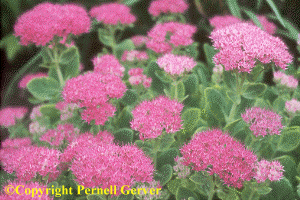 Sedum
'Brilliant' is one of my favorite autumn-blooming perennials
for sun. It's an upright-growing sedum that forms a handsome clump of
foliage. Its fleshy, chartreuse leaves are the perfect backdrop for
its large flat-topped clusters of flowers that stand atop its stems.
The flowers are brilliant pink and bloom in late summer and continue
blooming into early autumn. It grows about a foot and a half tall and
as wide. Sedum
'Brilliant' is one of my favorite autumn-blooming perennials
for sun. It's an upright-growing sedum that forms a handsome clump of
foliage. Its fleshy, chartreuse leaves are the perfect backdrop for
its large flat-topped clusters of flowers that stand atop its stems.
The flowers are brilliant pink and bloom in late summer and continue
blooming into early autumn. It grows about a foot and a half tall and
as wide.
 Sedum
'Autumn Joy' is the most common of the autumn-blooming
sedums. Like 'Brilliant,'
it's an upright-growing sedum that forms a wide clump of foliage. It
has thick, fleshy leaves that line its stems. Flat-topped flower
clusters form in early summer and begin turning shades of rose mauve
in late summer. As the flowers age, their color deepens to copper
bronze. It stands nearly two feet high and wide. Sedum
'Autumn Joy' is the most common of the autumn-blooming
sedums. Like 'Brilliant,'
it's an upright-growing sedum that forms a wide clump of foliage. It
has thick, fleshy leaves that line its stems. Flat-topped flower
clusters form in early summer and begin turning shades of rose mauve
in late summer. As the flowers age, their color deepens to copper
bronze. It stands nearly two feet high and wide.
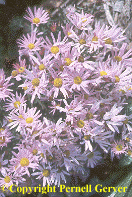 Dendranthema
'Sheffield' is truly a "hardy" mum. It comes back
reliably year after year. It's also one of the last plants to bloom
in my garden. It bears single, salmon-pink, daisy-like flowers on
stems that can grow to three feet tall. The flowers begin blooming in
late October and have been in bloom in my garden as late as
Thanksgiving. It will be in bloom long after frost has claimed the
annuals and most of the other perennials. It combines nicely with the
other autumn-blooming perennials and extends the bloom season well
into fall. Dendranthema
'Sheffield' is truly a "hardy" mum. It comes back
reliably year after year. It's also one of the last plants to bloom
in my garden. It bears single, salmon-pink, daisy-like flowers on
stems that can grow to three feet tall. The flowers begin blooming in
late October and have been in bloom in my garden as late as
Thanksgiving. It will be in bloom long after frost has claimed the
annuals and most of the other perennials. It combines nicely with the
other autumn-blooming perennials and extends the bloom season well
into fall.
During spring and summer,
ornamental grasses are perennials that provide a graceful, green
backdrop in the garden, but in fall and winter as other plants go
dormant and disappear, ornamental grasses suddenly emerge as focal
points in the garden. Their fluffy seed heads appear and sway
delicately in the breeze and their arching foliage turns a golden tan.
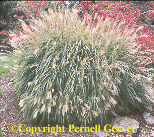 There
are many different types of ornamental grasses. One of my favorites
is miscanthus. Of the many varieties of miscanthus, one of the best
is Dwarf
Miscanthus 'Adagio.' It's much more
compact than most miscanthus. It forms a handsome clump of slender,
arching foliage about four feet high and wide. It produces an
abundance of flower plumes that appear in mid August. The foliage has
a thin stripe of white running down the center of each leaf. Because
of its compact size, it's a good choice for a small garden. There
are many different types of ornamental grasses. One of my favorites
is miscanthus. Of the many varieties of miscanthus, one of the best
is Dwarf
Miscanthus 'Adagio.' It's much more
compact than most miscanthus. It forms a handsome clump of slender,
arching foliage about four feet high and wide. It produces an
abundance of flower plumes that appear in mid August. The foliage has
a thin stripe of white running down the center of each leaf. Because
of its compact size, it's a good choice for a small garden.
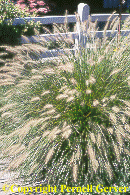 Another
nice ornamental grass for smaller gardens is dwarf
fountain grass. The variety 'Hameln'
forms a perfect, rounded mound of arching foliage. It grows only
about two feet high and wide. Rising through the foliage are
bottle-brush-shaped flower plumes. The flowers appear in late summer
and remain attractive through winter. Another
nice ornamental grass for smaller gardens is dwarf
fountain grass. The variety 'Hameln'
forms a perfect, rounded mound of arching foliage. It grows only
about two feet high and wide. Rising through the foliage are
bottle-brush-shaped flower plumes. The flowers appear in late summer
and remain attractive through winter.
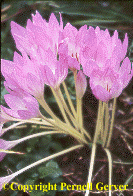 Two
fall-blooming bulbs called colchicum provide colorful flowers late
in the season. They're rather rare and lesser known, but they
definitely deserve a spot in any garden. The variety 'Lilac
Wonder' bears huge lilac-pink, crocus-shaped flowers that
burst out of the ground with no warning in autumn. Foliage appears in
spring, then dies back. A mature bulb can produce 20 or more flowers. Two
fall-blooming bulbs called colchicum provide colorful flowers late
in the season. They're rather rare and lesser known, but they
definitely deserve a spot in any garden. The variety 'Lilac
Wonder' bears huge lilac-pink, crocus-shaped flowers that
burst out of the ground with no warning in autumn. Foliage appears in
spring, then dies back. A mature bulb can produce 20 or more flowers.
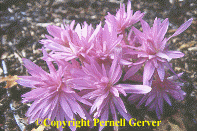
'Waterlily' bears
striking, bright lilac-pink double flowers that look just like a
waterlily bloom. They also appear in autumn without foliage. The
leaves grow in spring, then die back. A very choice and hard to find cultivar. |



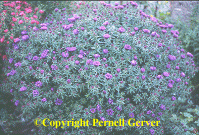 There
are many different types of asters that bloom in fall.
There
are many different types of asters that bloom in fall. 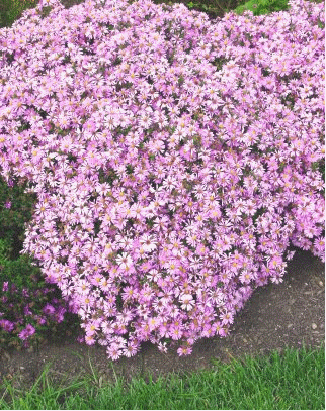 Aster
'Wood's Pink' is a compact aster that forms a tidy clump just 15
inches high and wide. It’s covered with small, vibrant-pink,
daisy-like flowers in late summer and early autumn, making it one of
the first of the fall-blooming asters to bloom.
Aster
'Wood's Pink' is a compact aster that forms a tidy clump just 15
inches high and wide. It’s covered with small, vibrant-pink,
daisy-like flowers in late summer and early autumn, making it one of
the first of the fall-blooming asters to bloom.
 Sedum
'Autumn Joy'
Sedum
'Autumn Joy' 
 There
are many different types of ornamental grasses. One of my favorites
is miscanthus. Of the many varieties of miscanthus, one of the best
is
There
are many different types of ornamental grasses. One of my favorites
is miscanthus. Of the many varieties of miscanthus, one of the best
is  Another
nice ornamental grass for smaller gardens is
Another
nice ornamental grass for smaller gardens is  Two
fall-blooming bulbs called colchicum provide colorful flowers late
in the season. They're rather rare and lesser known, but they
definitely deserve a spot in any garden. The variety
Two
fall-blooming bulbs called colchicum provide colorful flowers late
in the season. They're rather rare and lesser known, but they
definitely deserve a spot in any garden. The variety 
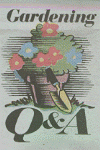 by
Pernell Gerver
by
Pernell Gerver Pernell
Gerver, Horticultural Communication Services All rights reserved.
Pernell
Gerver, Horticultural Communication Services All rights reserved.